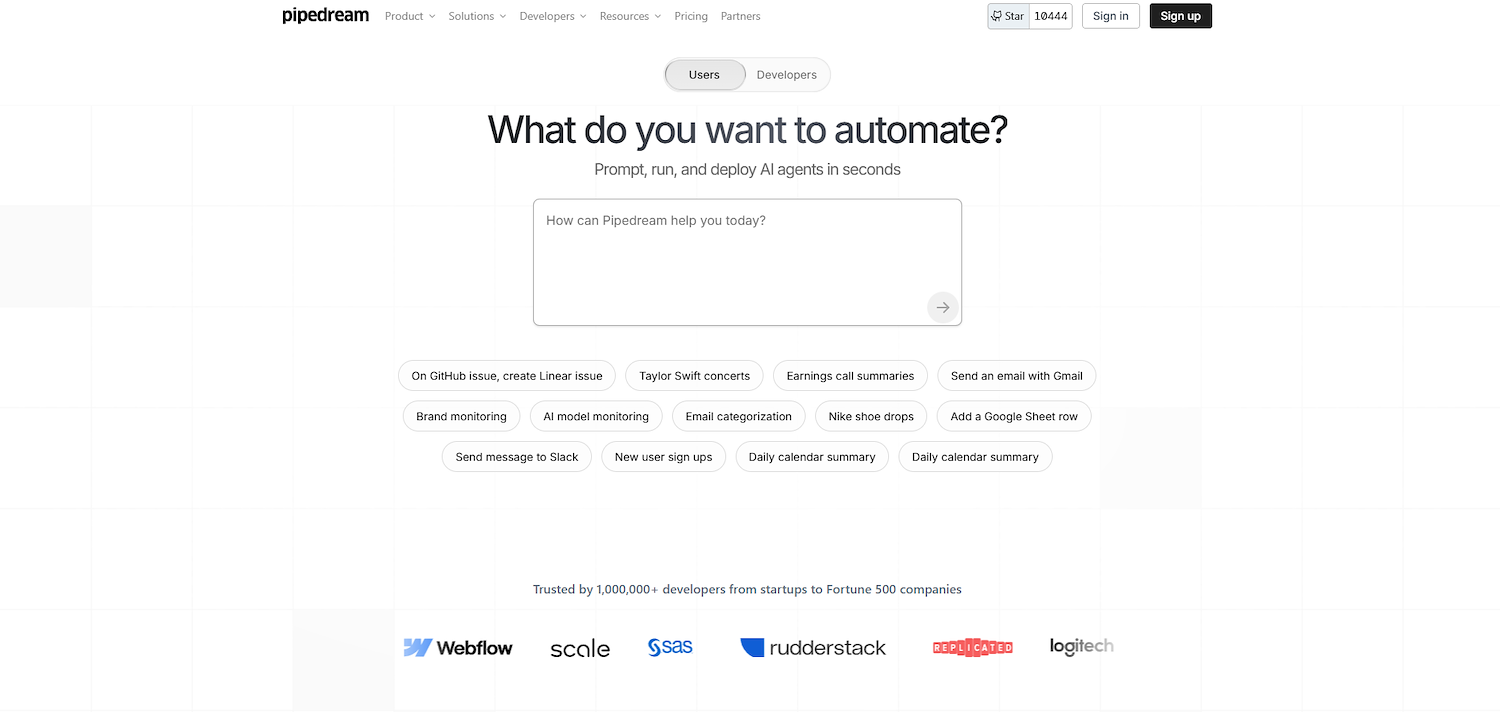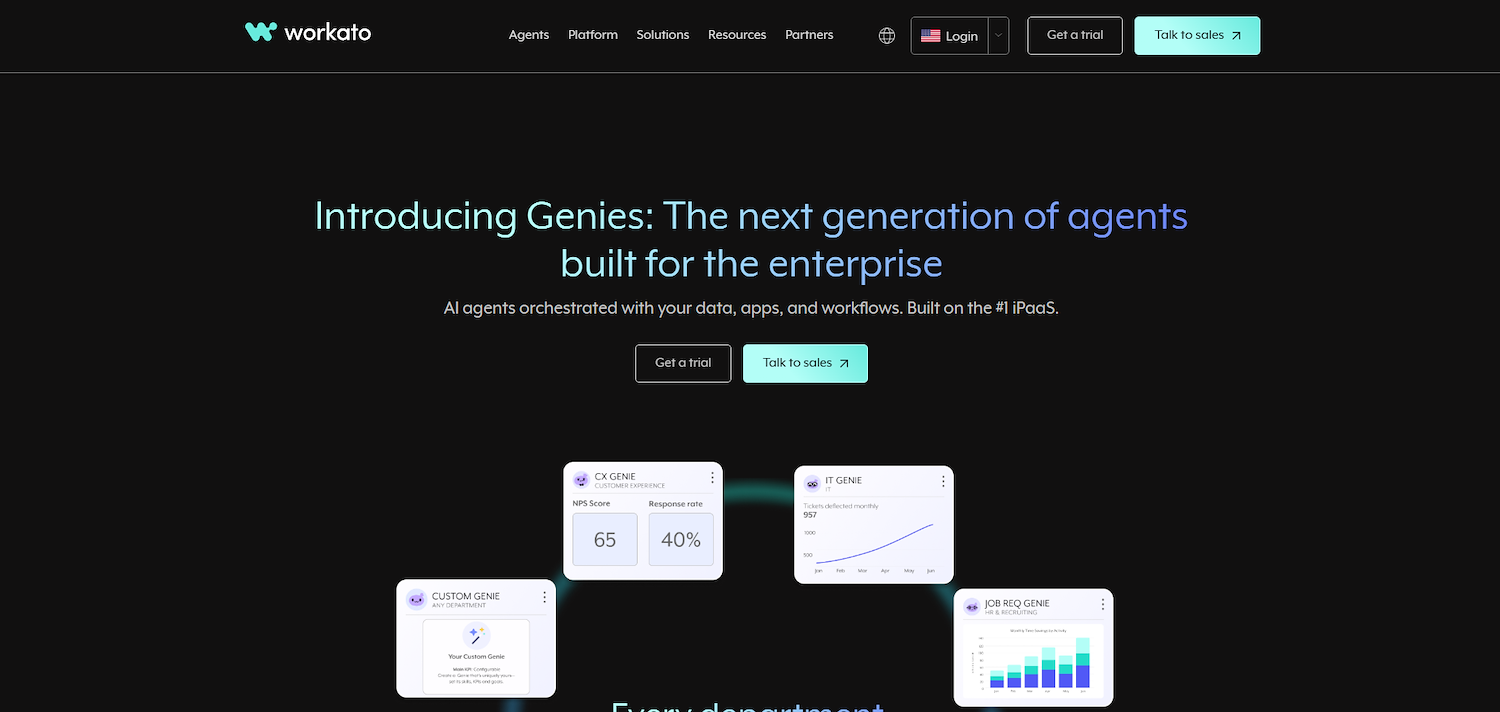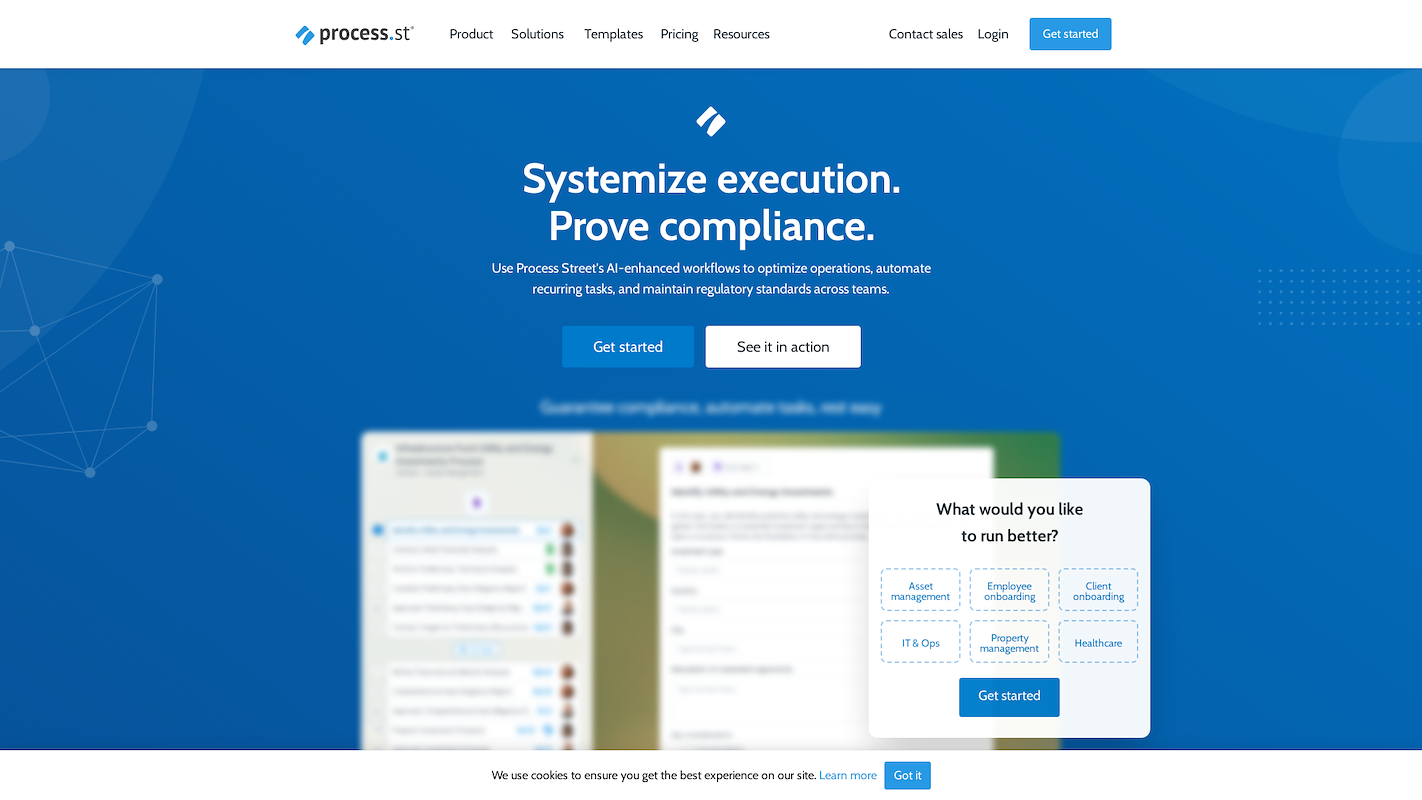Flyflow Alternatives
An in-depth comparison of 10 Flyflow alternatives. We analyze each tool's features, pricing, and performance to inform your decision.

You might be using Flyflow for very specific reasons. The tool performs well for its core functions, which makes it a solid choice for many teams. It gets the job done for its intended purpose.
But like any tool, it has limits. Some users say it can be complex or lacks certain features. We analyzed top alternatives based on G2 reviews to help you compare options and find a better fit. Let's get started.
Consider 11x for Your Sales Efforts
If your team needs to add digital workers for sales tasks, 11x is a relevant option. It provides autonomous agents to handle parts of your sales development process. You can review its functions to see if it fits your operational goals.
11x is a GTM platform that uses AI agents to manage the sales process. Its agent Alice finds prospects, performs outreach on email and LinkedIn, and maintains the CRM. Julian qualifies inbound leads and books meetings.
The platform consolidates functions like data enrichment, outreach, and email warmup. This can replace separate point solutions within a traditional GTM stack.
Flyflow Alternatives
Here is a detailed review of each Flyflow alternative. We analyze pricing, core features, and the specific advantages and potential drawbacks of each option when compared to Flyflow.
1) Zapier

Zapier is an AI orchestration platform to build automations. It connects over 300 AI tools with almost 8,000 SaaS applications. This gives organizations a central place to create AI workflows, chatbots, and agents. The platform allows users to build without code.
Its AI agents are custom autonomous agents that operate across an entire app stack. Use cases include IT help desk automation, lead management, and sales operations support.
Zapier's Main Features
- Builds visual, multi-step automations with logic branches and integrated AI processing.
- Deploys custom autonomous agents that operate across a user's complete app stack.
- Connects with over 8,000 SaaS applications and more than 300 AI tools like OpenAI and Anthropic.
- Creates drag-and-drop front-ends to interact with any established workflow.
How Zapier Compares to Flyflow
Average Review score: 4.5/5 stars based on 1,368 G2 reviews.
- Zapier connects with over 8,000 applications, offering much wider integration possibilities compared to Flyflow's more focused sales tool ecosystem.
- It provides a visual, no-code editor to build custom automations, which gives more flexibility than Flyflow's use of pre-defined AI agents for sales tasks.
- The platform supports a wide range of use cases beyond sales, including IT, marketing, and project management, while Flyflow is built specifically for sales development processes.
- Its custom AI agents can operate across an entire app stack for various functions. This is different from Flyflow's agents, which are designed for specific parts of the sales process.
How Zapier Is Different From Flyflow
- Zapier serves as a general automation tool. It does not have the specific, ready-to-use sales functions that Flyflow offers for sales development processes.
- Some users find that creating advanced sales automations in Zapier is complex. This is different from Flyflow, which uses dedicated AI agents for specific sales jobs.
- The tool connects with thousands of apps, but some users report that certain integrations are not very deep. This can sometimes be a limitation for specific sales tasks, unlike Flyflow's focus on the GTM stack.
Pricing and Cost-Effectiveness
Zapier offers a tiered pricing model that includes a free plan, a Starter plan at $19.99, and a Professional plan at $49.00. While specific Flyflow pricing is not available for a direct comparison, Zapier's structure offers a scalable, usage-based cost model suitable for general automation needs.
2) Make (formerly Integromat)

Make (formerly Integromat) is a visual, no-code/low-code automation platform. It lets organizations design, build, and scale workflows and AI-powered processes. The product offers visual orchestration of AI agents and connects with over 400 AI applications, including purpose-built agents that think and act in the moment.
Use cases span sales, IT, and marketing, with applications from lead management to AI-driven content creation and incident management.
Make (formerly Integromat)'s Main Features
- Offers a visual drag-and-drop builder that displays every step of a workflow.
- Connects with over 2,500 pre-built applications and any service with an API.
- Integrates with more than 400 AI tools and provides purpose-built “Make AI Agents” that act in the moment.
- Includes the Make Grid, a map of an organization’s automation landscape for insight and governance.
How Make Compares to Flyflow
Average Review score: 4.7/5 stars based on 241 G2 reviews.
- Make uses a visual drag-and-drop builder for custom workflows. This offers more flexibility than Flyflow's pre-defined AI agents, which handle specific sales tasks.
- It connects with over 2,500 applications and any service with an API. This is a wider range of integration options than Flyflow's focus on the sales tool ecosystem.
- The platform supports automation across various departments like sales, IT, and marketing. Flyflow, in comparison, is designed specifically for sales development processes.
- The tool lets users watch automations run in real time and provides detailed execution logs. This gives more granular control than the autonomous operation of Flyflow's agents.
- Its router module allows for complex workflows with multiple branches and logic paths. This is different from Flyflow's more linear, task-specific agent operations.
How Make Is Different From Flyflow
- Make is a general automation platform, so it does not have the specialized, ready-to-use sales functions that Flyflow offers for sales development processes.
- Some users find that building complex sales workflows in Make requires more technical skill. This is different from Flyflow, which uses dedicated AI agents for specific sales jobs.
- The tool connects with many apps, but some integrations might not be as deep for specific sales tasks. This can be a limitation compared to Flyflow's dedicated focus on the GTM stack.
Pricing and Cost-Effectiveness
Make offers a tiered pricing model with a free plan and paid plans starting at $9.00 per month. A direct comparison isn't possible as Flyflow's pricing is not public, but Make's structure provides a scalable entry point. For full details, visit Make (formerly Integromat)'s official website.
3) n8n

n8n is an open-source workflow automation platform for technical teams. It provides a visual builder and allows full code control with JavaScript or Python on the same canvas. Users can construct multi-step AI agents, connect any LLM, and create data chatbots.
The platform can be self-hosted for data control or used through its managed cloud service. This flexibility suits organizations with strict security requirements.
n8n's Main Features
- Combines a visual, drag-and-drop builder with full code control, allowing users to write JavaScript or Python on the same canvas.
- Offers flexible deployment options, including self-hosting on-premises for data control or using a managed cloud service.
- Provides tools to build multi-step AI agents, connect any LLM, and create data chatbots that interact through various communication channels.
- Includes a white-label embedding SDK that allows SaaS vendors to add automation features directly inside their own products.
How n8n Compares to Flyflow
Average Review score: 4.8/5 stars based on 92 G2 reviews.
- n8n provides a self-hosting option for organizations that need full control over their data. This is different from Flyflow, which operates as a cloud-based service without this deployment choice.
- It allows technical teams to write custom JavaScript or Python code directly within workflows. This offers a higher degree of customization compared to Flyflow's use of pre-defined agents for sales tasks.
- The platform is open-source, which gives users access to a large community and transparent development. Flyflow is a proprietary tool, so it does not offer this level of community-driven support or code access.
- A unique feature is its white-label embedding SDK, which lets companies add automation into their own products. Flyflow does not have a comparable feature for embedding its sales agents into other applications.
How n8n Is Different From Flyflow
- n8n does not provide pre-built AI agents for sales development, unlike Flyflow. Users must build their own sales workflows from scratch, which can require more setup time and technical knowledge.
- The platform is a general automation tool, so it lacks a user interface specifically designed for sales processes. Some users find that the UI can become cluttered when they build complex workflows.
- Its self-hosting option requires users to manage platform maintenance and updates. This is different from Flyflow, which operates as a fully managed service where the company handles all upkeep.
Pricing and Cost-Effectiveness
n8n offers tiered cloud plans starting at €20.00 per month and includes a self-hosting option. While Flyflow's pricing is not public, n8n's model provides a transparent and scalable cost structure, with the self-hosted version being a cost-effective choice for technical teams. For the most accurate pricing, visit n8n's official website.
4) Pipedream

Pipedream is an automation platform built for developers. It connects APIs to build event-driven workflows with code. The system provides a serverless environment to run functions based on application triggers.
This structure supports the creation of custom AI agents and data integrations. Users get code-level control for technical tasks without the need to manage infrastructure.
Pipedream's Main Features
- Provides an AI agent builder to prompt, run, edit, and deploy agents.
- Includes a workflow builder that combines a drag-and-drop interface with a code environment for API-driven processes.
- Offers a Pipedream Connect SDK to embed thousands of integrations directly into applications or agents.
- Contains built-in services like managed queues, data stores, and private networks for workflow creation.
How Pipedream Compares to Flyflow
Average Review score: 4.6/5 stars based on 15 G2 reviews.
- Pipedream gives developers code-level control to build custom workflows. This is different from Flyflow, which uses pre-defined AI agents for specific sales tasks.
- It operates in a serverless environment, which lets users run functions based on triggers without managing infrastructure. Flyflow, in contrast, provides fully managed agents for a set range of sales functions.
- The platform includes a Connect SDK to embed integrations directly into other applications. This offers a level of extensibility not present in Flyflow's closed system.
- This tool contains built-in services like managed queues and data stores for complex workflow creation. This provides more foundational building blocks compared to Flyflow's focus on ready-to-use sales features.
How Pipedream Is Different From Flyflow
- Pipedream requires technical knowledge to create workflows, which can present a learning curve for non-developer teams. This is different from Flyflow, which provides pre-configured AI agents for specific sales tasks.
- The platform does not offer specialized, out-of-the-box sales functions. Users must construct their own sales automations from scratch, unlike Flyflow's dedicated agents for prospecting and lead management.
- Some users report that its interface can feel complex when they build sales-specific workflows. This contrasts with Flyflow's user experience, which is tailored specifically for sales development representatives.
Pricing and Cost-Effectiveness
Pipedream's pricing details are not publicly available, which prevents a direct cost comparison with Flyflow. For the most accurate information, visit Pipedream's official website.
5) Tray.io

Tray.io is a low-code automation platform. It connects applications and automates workflows across a company's software stack. The platform enables teams to build complex processes and manage data flow between different services.
Its capabilities apply to sales process automation and lead management. The system can orchestrate AI agents for task execution inside these workflows, which supports team operations.
Tray.io's Main Features
- Offers a low-code visual builder with an AI Palette for prototyping and provides over 600 application connectors.
- Includes the Merlin Agent Builder, a low-code tool to design, test, and deploy generative AI agents with memory and context retention.
- Provides pre-built templates called Agent Accelerators for use cases like ITSM, knowledge management, and customer support.
- A feature called Merlin Guardian safeguards personally identifiable information and other sensitive data within AI workflows.
How Tray.io Compares to Flyflow
Average Review score: 4.5/5 stars based on 156 G2 reviews.
- Tray.io includes the Merlin Agent Builder, a low-code tool to design custom generative AI agents. This offers more flexibility compared to Flyflow's pre-defined agents for specific sales roles.
- It provides pre-built templates called Agent Accelerators for use cases like ITSM and customer support. This is different from Flyflow's specific focus on sales development tasks.
- The platform includes a feature called Merlin Guardian to safeguard sensitive data within AI workflows. This offers a specific data protection layer that is not a named feature in Flyflow's system.
- This tool functions as a full integration platform with features for API management and data transformation. This is a broader scope than Flyflow's focus on automating sales development representative tasks.
How Tray.io Is Different From Flyflow
- Tray.io does not have ready-to-use AI agents for sales development, unlike Flyflow. Users must build their own sales workflows, which some find complex compared to Flyflow's pre-configured system.
- The platform is a general automation tool, so its user interface is not designed for sales processes. This is different from Flyflow, which offers an experience tailored to the tasks of a sales development representative.
- While it connects to many apps, some users report that creating deep sales automations can be difficult. Flyflow, in contrast, focuses entirely on the GTM stack, providing more direct functionality for those tools.
Pricing and Cost-Effectiveness
Tray.io does not list public pricing, which prevents a direct cost comparison with Flyflow. For accurate details, you should request a quote through Tray.io's official website.
Tray.io does not list public pricing, which prevents a direct cost comparison with Flyflow. For accurate details, you should request a quote through Tray.io's official website.
Explore 11x for Sales Development
For teams that need digital workers in their sales process, 11x is a relevant choice. The platform provides autonomous agents for tasks like prospecting and outreach. This can support your existing sales development function. Review its capabilities to determine if it aligns with your goals.
With 11x, we run your sales playbook with AI. Alice finds prospects and handles outreach, while Julian qualifies leads and schedules meetings. We consolidate tools for data, outreach, and email warmup, replacing separate solutions in your GTM stack.
Book a demo to see 11x in action.
6) Workato

Workato is an enterprise automation platform. It connects applications and automates business processes across an organization. Companies use it to build workflows with AI capabilities for tasks in different departments.
The platform supports use cases that manage sales leads or onboard new employees. It focuses on integration and process automation to orchestrate complex operations without extensive code.
Workato's Main Features
- Provides AI agents like AgentX for IT and sales, and allows users to build custom agents in its Agent Studio.
- Includes an enterprise orchestration suite with iPaaS, API management, data orchestration, and B2B/EDI integration capabilities.
- Offers an embedded iPaaS with pre-built, white-labeled integrations for SaaS vendors to add automation into their products.
- Contains automation accelerators, which are out-of-the-box recipes for processes like ticket escalation, procure-to-pay, and payroll.
How Workato Compares to Flyflow
Average Review score: 4.7/5 stars based on 566 G2 reviews.
- Workato allows users to build custom agents in its Agent Studio for different departments. This offers more flexibility than Flyflow's pre-defined agents, which are set for specific sales roles.
- It supports automation across the entire enterprise with accelerators for processes like procure-to-pay. This is a broader scope compared to Flyflow's focus on sales development tasks.
- The platform includes an embedded iPaaS feature. This lets SaaS vendors add automation directly into their own products, an option not available with Flyflow's closed system.
- This tool offers full API management, including construction and monitoring. This provides deeper technical control for integrations, unlike Flyflow, which operates as an application for sales tasks.
How Workato Is Different From Flyflow
- Workato does not have ready-to-use AI agents for sales development. This differs from Flyflow, which gives users pre-set agents for specific sales jobs like prospecting and outreach.
- Its user interface is for general business automation. For this reason, some sales teams may find it less direct than Flyflow's interface, which is made for sales development work.
- Some users report that it is complex to build specific sales workflows. This is different from Flyflow, which simplifies these processes because it is built for the GTM stack.
Pricing and Cost-Effectiveness
Workato does not list public pricing, which prevents a direct cost comparison with Flyflow. For accurate details, you should request a quote through Workato's official website.
7) IFTTT

IFTTT is a service that connects apps and devices to automate tasks. It works on a conditional principle: if an event occurs in one service, it triggers an action in another. This lets users build command chains across their tools. The platform supports connections for smart home tech, social media, and other web services to automate routines for personal or professional use.
IFTTT's Main Features
- Creates automations through pre-built 'Applets' that connect over 900 web, mobile, and IoT services.
- Offers advanced automation controls, including filter code, queries, and multi-step Applets with multiple actions.
- Provides full-featured iOS and Android mobile apps to create and manage automations from anywhere.
- Includes an AI Content Creator to automatically generate blog and social posts.
How IFTTT Compares to Flyflow
Average Review score: 4.5/5 stars based on 113 G2 reviews.
- IFTTT connects with over 900 services, including smart home devices and social media. This offers a wider range of personal and professional tool integrations compared to Flyflow's focus on the sales software ecosystem.
- It provides full-featured mobile apps for iOS and Android to manage automations. This gives users on-the-go control, which is different from Flyflow's system designed for sales team operations.
- The platform includes an AI Content Creator to automatically generate social media and blog posts. This is a different application of AI than Flyflow's agents, which handle sales prospecting and outreach tasks.
- This tool uses simple, pre-built 'Applets' for basic automations. This approach is more direct for single tasks than Flyflow's autonomous agents that manage complex, multi-step sales processes.
How IFTTT Is Different From Flyflow
- IFTTT does not offer specialized AI agents for sales development. This is different from Flyflow, which provides pre-built agents designed specifically for tasks like prospecting and lead outreach.
- The platform uses simple 'Applets' for automation. Some users find these are not suitable for complex, multi-step sales workflows, which is a core function of Flyflow's autonomous agents.
- It connects to many services, but some users report that certain integrations are not deep enough for sales tasks. This is different from Flyflow's focus on the GTM stack, which allows for more direct process integration.
Pricing and Cost-Effectiveness
IFTTT offers tiered pricing with a free plan, but a direct cost comparison with Flyflow is not possible as Flyflow's pricing is not public. User reviews for IFTTT note that while it can be low-cost, paid plans may become expensive for advanced use. For current plan details, visit IFTTT's official website.
8) Boomi
Boomi is an integration platform as a service (iPaaS). It connects applications, data, and devices across hybrid IT environments. The platform helps organizations automate workflows and manage data synchronization between different systems. It is designed for enterprise-level integration projects.
Boomi's Main Features
- Provides a unified platform for application integration, data management, and workflow automation.
- Includes tools for API lifecycle management, from creation to security and monitoring.
- Offers a Master Data Hub to synchronize and govern data across the enterprise.
- Supports B2B/EDI management to automate partner and supplier transactions.
How Boomi Compares to Flyflow
Average Review score: 4.4/5 stars based on 461 G2 reviews.
- Boomi is an enterprise integration platform that connects an entire IT landscape. This is a much broader scope than Flyflow, which automates specific sales development tasks.
- It provides tools for API management and master data governance. These are technical, infrastructure-level features not present in Flyflow's application-focused system.
- The platform is built for complex, large-scale data synchronization projects. This is different from Flyflow's use of AI agents for front-end sales activities like prospecting and outreach.
- Boomi's user base typically includes IT professionals and developers. Flyflow, in contrast, is designed for sales development representatives and their managers.
How Boomi Is Different From Flyflow
- Boomi does not offer pre-built AI agents for sales development. Users must construct their own sales automations, which requires significant technical work compared to Flyflow's ready-to-use system.
- The platform has a steep learning curve. Some users report that it is complex and requires specialized training, unlike Flyflow's more direct interface for sales teams.
- Its focus is on back-end data integration. This means it lacks the user-facing features for sales outreach and prospect management that are central to Flyflow's purpose.
Pricing and Cost-Effectiveness
Boomi's pricing is not publicly available, so a direct cost comparison with Flyflow is not possible. Organizations must contact Boomi for a custom quote based on their integration needs. For details, visit Boomi's official website.

Boomi is an integration platform as a service (iPaaS) for enterprise-level projects. It connects applications, data, and devices across hybrid IT environments. The platform automates workflows and handles data synchronization between systems.
It also provides tools for API lifecycle management, a Master Data Hub to govern data, and B2B/EDI management for partner transactions.
Boomi's Main Features
- Includes tools for the full API lifecycle, covering construction, testing, management, and monitoring.
- Supports data integration with functions for data transformation, migration, and manipulation.
- Provides orchestration to automate workflows and handle application integration.
- Offers data security features and maintains logs and documentation for all processes.
How Boomi Compares to Flyflow
Average Review score: 4.4/5 stars based on 453 G2 reviews.
- Boomi connects an entire IT environment as an enterprise integration platform. This scope is broader compared to Flyflow, which focuses on specific sales development tasks.
- The platform offers tools for API management and a Master Data Hub for data governance. Flyflow does not have these technical, infrastructure-level features in its application-focused system.
- It handles complex, large-scale data synchronization projects. This function is different from Flyflow's use of AI agents for front-end sales activities like outreach.
- This tool serves IT professionals and developers who manage complex integrations. In contrast, Flyflow is made for sales development representatives and their managers.
How Boomi Is Different From Flyflow
- Boomi does not provide pre-built AI agents for sales development. This is different from Flyflow, which offers a ready-to-use system for specific tasks like prospecting and outreach.
- The platform can have a steep learning curve for non-technical users. Some reviews mention its complexity, which contrasts with Flyflow's interface designed for sales teams.
- Its primary focus is on back-end data integration between different systems. This means it lacks the front-end features for sales outreach that are central to Flyflow's purpose.
Pricing and Cost-Effectiveness
Boomi’s pricing is not publicly available, which prevents a direct cost comparison with Flyflow. Organizations must contact Boomi for a custom quote based on their integration needs. For details, visit Boomi's official website.
9) Parabola

Parabola is a data workflow automation platform for non-technical teams. It uses a drag-and-drop interface to build processes that handle data from different sources. Users can automate operational tasks and incorporate AI steps for data analysis and manipulation.
The tool is often applied to e-commerce, marketing, and logistics to manage information flows.
Parabola's Main Features
- Builds automated flows with data extraction and transformation capabilities.
- Includes generative AI functions for automatic text generation.
- Maintains an audit trail for process management and tracking activities.
- Manages dependencies between different steps within a workflow.
How Parabola Compares to Flyflow
Average Review score: 4.9/5 stars based on 33 G2 reviews.
- Parabola focuses on data extraction and transformation from sources like PDFs and spreadsheets. This is different from Flyflow, which uses agents for sales tasks instead of data manipulation.
- It provides a drag-and-drop interface for non-technical teams to build custom data workflows. This offers more manual control over process creation compared to Flyflow’s pre-set sales agents.
- The platform includes an audit trail to track all process activities. This gives users a detailed log for management, a feature distinct from the operational reports of Flyflow's agents.
- Its AI functions assist with text generation and data analysis within a workflow. Flyflow, in contrast, packages its AI into autonomous agents that perform specific sales development roles.
How Parabola Is Different From Flyflow
- Parabola does not offer ready-to-use AI agents for sales development. This is different from Flyflow, which provides pre-built agents to handle specific tasks like prospecting and lead outreach without requiring manual workflow construction.
- The tool is a general data automation platform, so it lacks a specific focus on the GTM stack. Some sales teams might find it less direct for their needs compared to Flyflow, which is built only for sales processes.
- Users must build their own sales workflows from the ground up. This can require more setup time and technical configuration than Flyflow's system, where sales agents are already configured for their roles.
Pricing and Cost-Effectiveness
Parabola offers a tiered model with a free plan, an Explorer plan starting at $20.00 per month, and a Team plan from $1,000.00 per month. A direct cost comparison with Flyflow is not possible as its pricing is not public. For current pricing, visit Parabola's official website.
10) Process Street

Process Street is a no-code platform for workflow and process management. It uses interactive checklists and AI-powered template generation to document and execute recurring procedures. Common applications include new employee setup, client implementation, and content approvals, which helps standardize operational tasks.
Process Street's Main Features
- Includes an embedded AI agent that monitors workflows in real time to identify risks and enforce compliance.
- Provides a no-code workflow engine to turn documents into structured processes with tasks, forms, and logic rules.
- Offers a controlled document management system with version history, approval workflows, and role-based permissions.
- Generates automatic audit-ready records by tracking all task activity and execution history.
How Process Street Compares to Flyflow
Average Review score: 4.6/5 stars based on 448 G2 reviews.
- Process Street includes an embedded AI agent that monitors workflows for compliance risks. This is different from Flyflow, whose agents focus on executing specific sales tasks like prospecting.
- It provides a system to turn documents like SOPs into structured, trackable workflows. This gives more control over internal procedures compared to Flyflow's focus on automating external sales outreach.
- The platform generates automatic audit-ready records by tracking all task history. This provides a level of documentation for compliance that is different from the sales performance reports in Flyflow.
- This tool helps standardize recurring procedures across different departments, such as employee onboarding. This offers broader operational use than Flyflow, which is built specifically for the sales development process.
How Process Street Is Different From Flyflow
- Process Street does not provide ready-to-use AI agents for sales development. This is different from Flyflow, which offers autonomous agents for specific tasks like prospecting and outreach.
- It focuses on internal procedures such as compliance and employee onboarding. The platform lacks the dedicated features for external sales activities, like automated lead engagement, which Flyflow handles.
- The tool requires users to build their own sales workflows from scratch. Some teams might find this setup more time-consuming compared to Flyflow's pre-configured agents that are ready for sales tasks.
Pricing and Cost-Effectiveness
Process Street does not list public pricing, which prevents a direct cost comparison with Flyflow. For accurate details, you should request a quote through Process Street's official website.
Which One Should You Go With?
Choosing a Flyflow alternative depends on many variables, including your team's technical skill and specific use case. This guide reviewed several options to help you find a suitable platform for your operational needs.
If your sales team needs digital workers, 11x is a relevant option. The platform provides autonomous agents for tasks like prospecting and outreach to support your sales development function. You can review its capabilities to see if it aligns with your goals.




